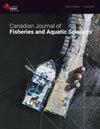北方河流鱼类的物种-环境关系、集群和温度范围
IF 2.2
2区 农林科学
Q2 FISHERIES
Canadian Journal of Fisheries and Aquatic Sciences
Pub Date : 2023-11-14
DOI:10.1139/cjfas-2023-0016
引用次数: 0
摘要
了解关键环境因素如何影响鱼类群落对健全的环境管理是必要的。因此,我们研究了芬兰北方河流中鱼类物种与环境的关系。自组织图(SOM)分析表明,18种鱼类的发生与10个环境变量之间存在较强的关系(方差解释率为43.4%)。在我们对每种鱼类运行的逻辑回归模型中,预测能力从差(AUC = 0.67-0.68)到优(AUC = 0.96)不等,表明响应是物种特异性的。对物种发生的最佳预测因子是局地变量水深和水温,局地变量流大小、海拔和年平均温度。我们的研究结果揭示了通过SOM识别的鱼类组合类型(集群)和通过分层聚类分析发现的鱼类共现现象,揭示了河流鱼类组合的结构。此外,我们的研究结果表明,河流的大小有助于每个物种能够发生的温度范围,这与预测气候变化对河流鱼类的影响有关。本文章由计算机程序翻译,如有差异,请以英文原文为准。
Species–environment relationships, clusters, and thermal ranges of fish species inhabiting boreal rivers
Understanding how key environmental factors affect fish communities is necessary for sound environmental management. Accordingly, we studied fish species–environment relationships in Finnish boreal rivers. A self-organizing map (SOM) analysis showed strong relationships between the occurrence of 18 fish species and 10 environmental variables (variance explained: 43.4%). In our logistic regression models run for each fish species, the predictive power varied from poor (AUC = 0.67–0.68) to excellent (AUC = 0.96), indicating that the responses were species-specific. The overall best predictors of the species occurrence were the local variables water depth and water temperature, and the regional variables stream size, altitude and annual mean temperature. Our results on fish assemblage types (clusters), identified by SOM, and co-occurrence of fish species, discovered by a hierarchical cluster analysis, reveal insights into the structure of the river fish assemblages. Moreover, our results suggest that the stream size contributes to thermal ranges in which each species is able to occur, which has relevance to predicting the impacts of climate change on riverine fish.
求助全文
通过发布文献求助,成功后即可免费获取论文全文。
去求助
来源期刊

Canadian Journal of Fisheries and Aquatic Sciences
农林科学-海洋与淡水生物学
CiteScore
4.60
自引率
12.50%
发文量
148
审稿时长
6-16 weeks
期刊介绍:
The Canadian Journal of Fisheries and Aquatic Sciences is the primary publishing vehicle for the multidisciplinary field of aquatic sciences. It publishes perspectives (syntheses, critiques, and re-evaluations), discussions (comments and replies), articles, and rapid communications, relating to current research on -omics, cells, organisms, populations, ecosystems, or processes that affect aquatic systems. The journal seeks to amplify, modify, question, or redirect accumulated knowledge in the field of fisheries and aquatic science.
 求助内容:
求助内容: 应助结果提醒方式:
应助结果提醒方式:


